Road Safety for Cyclists and Motorists - The Ultimate Online Guide
This study was proudly brought to you by Intelligent Car Leasing. For any leasing offers or options, please don't hesitate to check out our car leasing deals page for thousands of special offers.
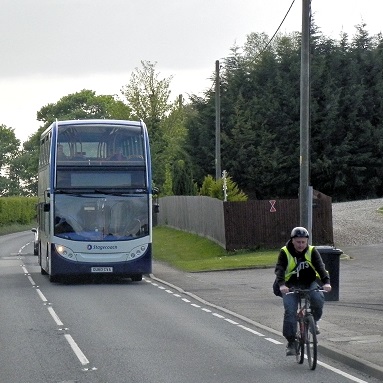 Few subjects cause more tension than the relationship between drivers and cyclists on our roads. It is not an easy partnership, and there will always be some level of animosity between two and four wheeled road users. However whether you’re a driver, cyclist or both, one thing we do need to be on the same page about is SAFETY.
Few subjects cause more tension than the relationship between drivers and cyclists on our roads. It is not an easy partnership, and there will always be some level of animosity between two and four wheeled road users. However whether you’re a driver, cyclist or both, one thing we do need to be on the same page about is SAFETY.
ROSPA provides the statistics on collisions involving cyclists below:
• Around 75% of fatal or serious cyclist accidents occur in urban areas
• Around half of cyclist fatalities occur on rural roads
• 75% happen at, or near, a road junction
• 80% occur in daylight
• 80% of cyclist casualties are male
• Almost one quarter of the cyclists killed or injured are children
• Around three quarters of cyclists killed have major head injuries.
These stats highlight the need for improved road safety awareness for all users, in order to reduce the level of accidents on our roads.
Key Safety Measures for Road Cyclists
1. Be Aware of EVERYTHING on the Road
Cycling on the road with other vehicles requires more concentration than just driving alone. In a car you need to be aware of everything else on the road, but on a bike you need to be aware of all of this AND make sure you're noticed too.
At all times you need to have a high level of awareness of:
- Driver's turning intentions (remember they won't always indicate).
- Your positioning in relation to a driver's blind spot.
-
Any objects/hazards which could quickly become an obstruction, such as car doors, wheelie bins, children playing etc.
2. Maintain High Visibility at All Times
Making sure you are seen is one of the biggest steps you can take to protecting yourself as a cyclist. Most collisions occur because cyclists are not seen (or are only seen too late). Make sure you ride in a visible position on the road at all times, and try to make eye contact with motorists so you know they've seen you.
The following gear is vital for cyclists to be seen:
- Brightly coloured clothing which will catch the eye of drivers.
- High visibility and reflective wear for when cycling in low-light conditions.
- A front white light and a flashing red rear light.
3. Know the Rules of the Road
It is the responsibility of all cyclists and drivers to know the rules of the road. This comes in the form of the highway code, which is readily available for free online.
Click hereto view the highway code for cyclists.
Being aware of the rules is not only beneficial for your safety, if *touch wood* you do get into an accident, being in the right can vastly increase your chances of any legal action being taken against you.
It will also keep you out of trouble with the police for any traffic offences you might unknowingly commit.
4. Signal Your Intentions Appropriately
Just as all drivers should indicate and not assume people know what they are doing, so too should cyclists.
There are certain hand signals you must know before setting out on the road:
- Right or Left Turn - One arm extended horizontally in the direction you are about to turn.
- Slowing down - One arm slightly extended to the side with the palm facing down. Raise your hand up and down at wrist height.
-
Stopping - One arm extended vertically upwards with the palm facing forward.
5. Have and Use a Bell
Drivers and cyclists need to be alert of each other's presence, but both parties also need to be aware of pedestrians. Motorists can warn pedestrians of their presence with the use of a horn. However cyclists do not have this inherently built in and need to invest in some form of warning system.
Most people opt for the simple bell, but there are all sorts of devices you can buy to alert others of your presence when cycling. These range from physical horns to various digital devices that generate a warning noise.
If all else fails you can shout to warn pedestrians but this will likely be the least effective option.
6. Maintain Your Bike Regularly
Bicycle maintenance is just as import as making sure a vehicle is in good running order. You should regularly perform checks on tyres and brakes to make sure they're in full working order and aren't close to issues through wear.
A tyre tear or puncture at high speed can be disastrous, as can brakes that are worn or slow to stop. Therefore never commence a journey if you know that your bicycle isn't in a completely safe condition.
It is also advisable to have your bike serviced once a year from a professional.
Key Safety Measures for Vehicle Drivers
Guide provided by ICL - The Car Leasing Specialists.
1. Always Check Mirrors and Blind Spots
It is imperative that motorists check their near side mirrors AND their blind spot before setting off from a fixed position. Doing so can be the difference between noticing a cyclist and being unaware of their presence which is a dangerous position to be in.
2. Give Appropriate Space When Overtaking Cyclists
It is recommended that motorists give cyclists at least 1.5m of space when passing them. For cars this is usually remembered by the short-cut of 1 car's width of space.
3. Know the Rules of the Road
Just as we recommend that cyclists should know the highway code, the same advice applies to drivers (perhaps even more so). All road users should be fully aware of what is expected of them in order to navigate their journeys in the safest possible manner.
We advise that drivers not only know what is expected of them, but specifically read up the advice which is posted for cyclists as well.
4. Signal Your Intentions Clearly
70% of collisions involving cyclists are caused by driver error or fault, and not indicating is one of the biggest errors that drivers can make. If you can make other road users aware of your intentions as early as is possible then the everyone's risk level is lowered.
Therefore make sure that you appropriately use your indicators, hazard warning lights and try to physically brake using the pedal to slow down as this alerts road users behind you.
5. Keep your Aggression at Bay
One of the most dangerous things a driver can do is lose control of their emotions. Road rage causes motorists to lose a large degree of control and cyclists are often a source of frustration.
You need to keep in mind that cyclists have as much right to use the road as you, and comprising their safety to avoid a temporary delay is not acceptable.
6. Control Your Lights at Night
Just as you should with oncoming cars, make sure that you dip your headlights when opposite cyclists at night. A bright headlight can easy dazzle someone, causing them to lose control and end up in a collision with yourself or others.
Avoiding Collisions for Cyclists & Motorists
Collision 1: Junction Hit
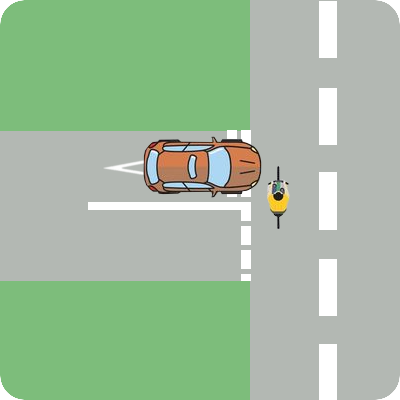 The majority of collisions between vehicles and cyclists on the road occur at a junction. It is most common for a bicycle to get hit by a vehicle pulling out of a junction, but it can also happen when a vehicle is turning into a junction, driveway or layby.
The majority of collisions between vehicles and cyclists on the road occur at a junction. It is most common for a bicycle to get hit by a vehicle pulling out of a junction, but it can also happen when a vehicle is turning into a junction, driveway or layby.
There are two possible collisions that can happen at a junction or entry/exit point to the road. The first is that the vehicle pulls out onto the road ahead of the cyclist, causing a collision between the front of the bike and the side of the vehicle. The second is that the vehicle pulls out onto the road as the cyclist is passing, causing a collision between the front/rear of the vehicle and side of the bike.
Ways to Avoid:
The most likely reason that a driver will collide with a cyclist is that they cannot see them. Therefore, as above you want to make sure you’re highly visible at all times. At night this means making sure that you have a white front light and a red flashing rear light, both of which are in full working order. Not only is this part of the Highway Code, which should be followed by all road users, but it is common sense as well. High visibility clothing with reflective panels is also advised when cycling at night time.
During the day you should still take measures to ensure that you are visible, it’s recommended to wear fluorescent clothing and even keep your lights on too.
In addition to wearing the correct apparel and having appropriate lights on your bike, there are other steps you can take to improve your visibility. These mainly involve physical signals such as waving to get the driver’s attention and making sure you catch their eye to know they’ve seen you.
If you want to be as safe as possible it’s best to slow down to a speed that you can stop completely if you need to when going past junctions. Although this is frustrating it keeps you in control of the situation.
Collision 2: Sudden Obstruction
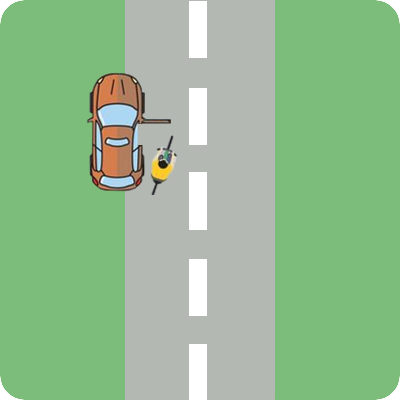 Another way for cyclists to become involved in an accident is to collide with a sudden obstruction. In many cases this will be a driver’s car door which has been opened without looking to see what is coming. However it could be any object suddenly appearing in a cyclist’s path such as a wheelie bin being blown over or a ball rolling onto the road.
Another way for cyclists to become involved in an accident is to collide with a sudden obstruction. In many cases this will be a driver’s car door which has been opened without looking to see what is coming. However it could be any object suddenly appearing in a cyclist’s path such as a wheelie bin being blown over or a ball rolling onto the road.
This type of obstruction, by nature, is usually very sudden to appear so the amount of time you have to react is minimal.
Ways to Avoid:
Unfortunately if the obstacle presents itself at the last minute there isn’t a lot that can be done to avoid it. However your road positioning in general can reduce the risk you expose yourself to. If you stay further to the right of your lane, then any fast emerging objects will be easier to avoid as there’s less of a sharp turn needed.
There is also as above the point of making yourself as visible as possible. This way (especially at night) drivers opening their door will have the best chance of seeing you before they do so.
Collision 3: Overtake Turn
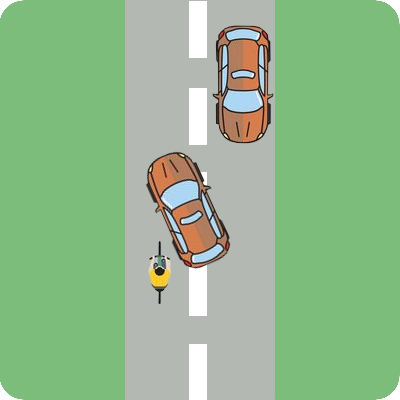 Overtaking is probably the second most dangerous aspect of sharing the road behind navigating junctions. There are two types of risk which emerge from overtaking on the road, one is when cars overtake cyclists and the other is when cyclists overtake cars (or other cyclists).
Overtaking is probably the second most dangerous aspect of sharing the road behind navigating junctions. There are two types of risk which emerge from overtaking on the road, one is when cars overtake cyclists and the other is when cyclists overtake cars (or other cyclists).
Firstly when a car is overtaking a cyclist there are a lot of risks. One is that they do not give the cyclist enough room when overtaking, forcing the cyclist to move closer to the kerb and put themselves in more danger. Another risk from cars overtaking cyclists is that they cut back in too soon and clip the cyclist or force them to stop suddenly to avoid being clipped. Finally there is the risk of a vehicle overtaking a cyclist just before making a turn. In this case the vehicle cuts across the cyclist’s path causing a blockade which can result in a collision to the side of the vehicle.
On the other hand when a cyclist overtakes a slow moving vehicle there are also imposed risks. A vehicle could be slowing down as it is about to make a turn but hasn’t indicated. Therefore extra caution needs to be taken when proceeding with such a manoeuvre.
Ways to Avoid:
One of the best ways to avoid accidents involving vehicles overtaking you as a cyclist is to make sure you’re in the middle of the lane. It is tempting to ride tucked in beside the kerb but all this does is invite motorists to overtake you. If you ride in the middle of your lane motorists will only overtake you if there is no traffic on the other side of the road. However if you are a “kerb hugger” it will look a lot more inviting to risky motorists to try and squeeze past.
As for when motorists are overtaking you, the safest course of action is to slow down slightly, which should create a little more distance and lessen the risk of them cutting in too soon.
Collision 4: Traffic Light Stop
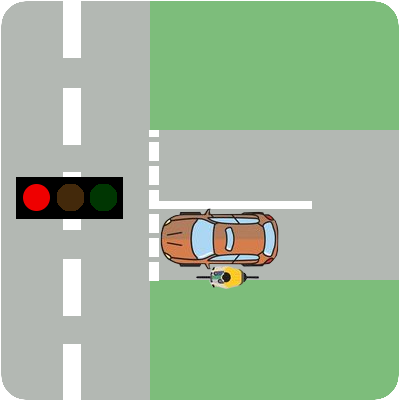 Traffic lights can cause all sorts of problems for motorists and cyclists, it is all to do with positioning and visibility. Problems can occur if a cyclist sits to the side of a vehicle in the driver’s blind spot. When the light turns green if the driver isn’t aware of the cyclist presence they can turn into them causing a nasty collision.
Traffic lights can cause all sorts of problems for motorists and cyclists, it is all to do with positioning and visibility. Problems can occur if a cyclist sits to the side of a vehicle in the driver’s blind spot. When the light turns green if the driver isn’t aware of the cyclist presence they can turn into them causing a nasty collision.
This problem is most dangerous when it comes to larger vehicles and lorries. There have been incidents recorded of cyclist deaths from being crushed under wheels in such accidents.
Ways to Avoid:
The solution to this risk is a simple one, always queue behind the vehicle in front. That way the car behind you has a clear view and there’s zero risk of the car in front doing a sharp turn into you.
Collision 5: Rear End
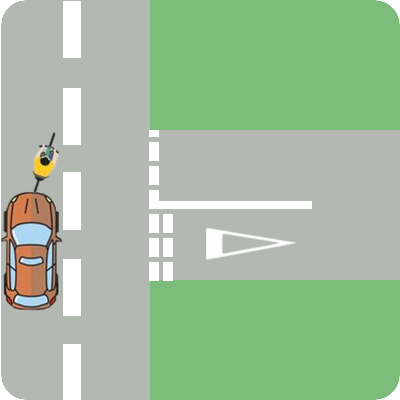 This is the most feared type of collision for cyclists as the vehicle makes contact from behind. When the danger emerges from behind a cyclist they have no way of seeing or anticipating it. In the scenarios discussed above it is usually clear cut whose fault the accident is. Although for read end collisions it can equally be either party who is to blame.
This is the most feared type of collision for cyclists as the vehicle makes contact from behind. When the danger emerges from behind a cyclist they have no way of seeing or anticipating it. In the scenarios discussed above it is usually clear cut whose fault the accident is. Although for read end collisions it can equally be either party who is to blame.
The reason for such a collision can be one of various reasons:
- The cyclist ‘jumps out’ onto the road suddenly from the pavement and the driver cannot stop in time.
- The cyclist brakes suddenly without warning and the driver cannot react in time.
- The driver is overzealous in speeding up (possibly to make it through a traffic light) and cannot stop in time.
- Driver isn’t paying attention to the road ahead (changing radio station, reaching for something etc.)
- The cyclist isn’t visible from behind at night and the driver does not have enough time to stop when they come into view.
Ways to Avoid:
One of the easiest ways you can avoid this collision is again to make sure that you’re as visible as possible. This means ensuring you wear high visibility and reflective clothing when cycling at night, making sure you have a rear light and a rear reflector.
The second way you can help yourself is to attach a rear view mirror to your bike. This way you can see what is going on behind you without having to turn your head and become completely blind to the road ahead.
Finally if you’re pulling out onto the road from the pavement always do so carefully, signalling your intention and double checking the road for any oncoming traffic before setting off.

